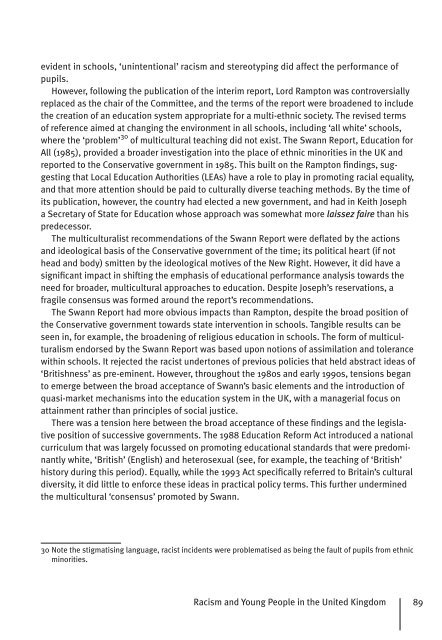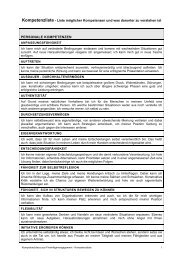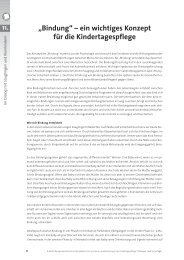Prevention of Right-Wing Extremism, Xenophobia and Racism in ...
Prevention of Right-Wing Extremism, Xenophobia and Racism in ...
Prevention of Right-Wing Extremism, Xenophobia and Racism in ...
Create successful ePaper yourself
Turn your PDF publications into a flip-book with our unique Google optimized e-Paper software.
evident <strong>in</strong> schools, ‘un<strong>in</strong>tentional’ racism <strong>and</strong> stereotyp<strong>in</strong>g did affect the performance <strong>of</strong><br />
pupils.<br />
However, follow<strong>in</strong>g the publication <strong>of</strong> the <strong>in</strong>terim report, Lord Rampton was controversially<br />
replaced as the chair <strong>of</strong> the Committee, <strong>and</strong> <strong>and</strong> the terms <strong>of</strong> the report were broadened to <strong>in</strong>clude<br />
the creation <strong>of</strong> an education system appropriate for a multi-ethnic society. The revised terms<br />
<strong>of</strong> reference aimed at chang<strong>in</strong>g the environment <strong>in</strong> all schools, <strong>in</strong>clud<strong>in</strong>g ‘all white’ schools,<br />
where the ‘problem’ 30 <strong>of</strong> multicultural teach<strong>in</strong>g did not exist. The Swann Report, Education for<br />
All (1985), provided a broader <strong>in</strong>vestigation <strong>in</strong>to the place <strong>of</strong> ethnic m<strong>in</strong>orities <strong>in</strong> the UK <strong>and</strong><br />
reported to the Conservative government <strong>in</strong> 1985. This built on the Rampton fi nd<strong>in</strong>gs, sug-<br />
gest<strong>in</strong>g that Local Education Authorities (LEAs) have a role to play <strong>in</strong> promot<strong>in</strong>g racial equality,<br />
<strong>and</strong> that more attention should be paid to culturally diverse teach<strong>in</strong>g methods. By the time <strong>of</strong><br />
its publication, however, the country had elected a new government, <strong>and</strong> had <strong>in</strong> Keith Joseph<br />
a Secretary <strong>of</strong> State for Education whose approach was somewhat more laissez faire than his<br />
predecessor.<br />
The multiculturalist recommendations <strong>of</strong> the Swann Report were defl ated by the actions<br />
<strong>and</strong> ideological basis <strong>of</strong> the Conservative Conservative government <strong>of</strong> the time; its political heart (if not<br />
head <strong>and</strong> body) smitten by the ideological motives <strong>of</strong> the New <strong>Right</strong>. However, it did have a<br />
signifi cant impact <strong>in</strong> shift<strong>in</strong>g the emphasis <strong>of</strong> educational performance analysis towards the<br />
need for broader, multicultural approaches to education. Despite Joseph’s reservations, a<br />
fragile consensus was formed around the report’s recommendations.<br />
The Swann Report had more obvious impacts than Rampton, despite the broad position <strong>of</strong><br />
the Conservative government towards state <strong>in</strong>tervention <strong>in</strong> schools. Tangible results can be<br />
seen <strong>in</strong>, for example, the broaden<strong>in</strong>g <strong>of</strong> religious education <strong>in</strong> schools. The form <strong>of</strong> multicul-<br />
turalism endorsed by the Swann Report was based upon notions <strong>of</strong> assimilation <strong>and</strong> tolerance<br />
with<strong>in</strong> schools. It rejected the racist undertones <strong>of</strong> previous policies that held abstract ideas <strong>of</strong><br />
‘Britishness’ as pre-em<strong>in</strong>ent. However, throughout the 1980s <strong>and</strong> early 1990s, tensions began<br />
to emerge between the broad acceptance <strong>of</strong> Swann’s basic elements <strong>and</strong> the <strong>in</strong>troduction <strong>of</strong><br />
quasi-market mechanisms <strong>in</strong>to the education system <strong>in</strong> the UK, with a managerial focus on<br />
atta<strong>in</strong>ment rather than pr<strong>in</strong>ciples <strong>of</strong> social justice.<br />
There was a tension here between the broad acceptance <strong>of</strong> these fi nd<strong>in</strong>gs <strong>and</strong> the legislalegisla- tive position <strong>of</strong> successive governments. The 1988 Education Reform Act <strong>in</strong>troduced a national<br />
curriculum that was largely focussed on promot<strong>in</strong>g educational st<strong>and</strong>ards that were predomi-<br />
nantly white, ‘British’ (English) <strong>and</strong> heterosexual (see, for example, the teach<strong>in</strong>g <strong>of</strong> ‘British’<br />
history dur<strong>in</strong>g this period). Equally, while the 1993 Act specifi cally referred to Brita<strong>in</strong>’s cultural<br />
diversity, it did little to enforce these ideas <strong>in</strong> practical policy terms. This further underm<strong>in</strong>ed<br />
the multicultural ‘consensus’ promoted by Swann.<br />
30 Note the stigmatis<strong>in</strong>g language, racist <strong>in</strong>cidents were problematised as be<strong>in</strong>g the fault <strong>of</strong> pupils from ethnic<br />
m<strong>in</strong>orities.<br />
<strong>Racism</strong> <strong>and</strong> Young People <strong>in</strong> the United K<strong>in</strong>gdom<br />
89

















